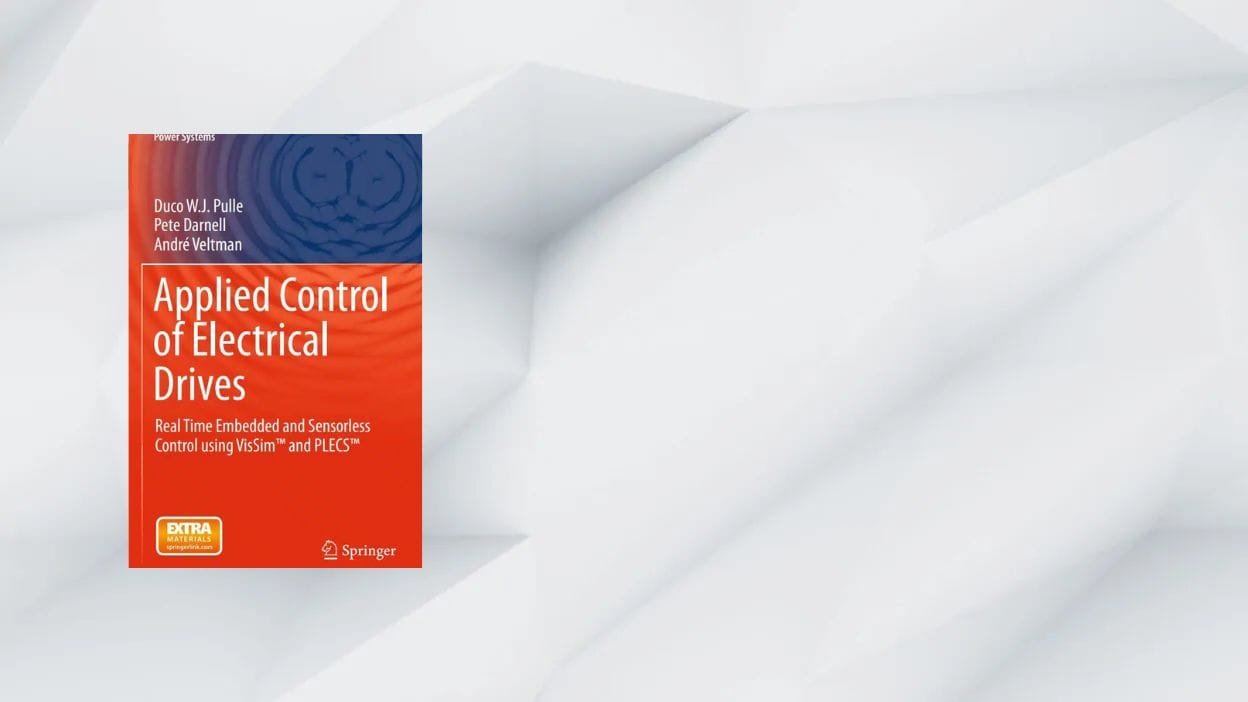Book at a Glance
| Detail | Snapshot |
|---|---|
| Title | Applied Control Of Electrical Drives |
| Subtitle | Real-Time Embedded and Sensorless Control using VisSim™ and PLECS™ |
| Authors | Duco W. J. Pulle, Pete Darnell, André Veltman |
| Series | Springer “Power Systems” |
| Edition | 1st |
| Publication Dates | eBook – 17 Sep 2015 · Hardcover – 15 Jan 2016 · Softcover – 30 Mar 2018 |
| Pages / Illustrations | 417 pp · 16 color & b/w figures |
| ISBN | 978-3-319-20042-2 (print) / 978-3-319-20043-9 (eBook) |
| Core Topics | Mathematical modeling, PWM converters, sensorless PM & induction drives, real-time C code generation, VisSim & PLECS labs |
| Target Audience | R&D engineers, graduate students, control firmware designers, test engineers |
Why Applied Control Of Electrical Drives Matters
Modern EV powertrains, robotics, and renewables all hinge on precise, software-centric motor control. Pulle, Darnell, and Veltman bridge the classroom–lab divide by coupling rigorous theory with executable VisSim/PLECS labs and ready-to-flash DSP code. For engineers tasked with wringing every watt of efficiency from a drive under hard real-time deadlines, this book is both blueprint and toolkit.
Chapter Highlights
- Primer on Electrical Drives – Reviews torque production, machine equations, and inverter topologies with clear vector diagrams.
- Power Electronic Converters – Details MOSFET/IGBT PWM strategies and harmonic impact on machine iron.
- Dynamic Modeling in d-q Axes – Derives state-space models for DC, induction, and synchronous machines, prepping readers for field-oriented control.
- Real-Time DSP Implementation – Explains fixed-point traps, CPU cycle budgeting, and interrupt design.
- Sensorless PM & Induction Drives – Guides through back-EMF observers, PLL estimators, and low-speed saliency tracking.
- VisSim™ & PLECS™ Workbenches – Step-by-step labs build from open-loop V/f to full vector control—exporting C code directly to TI and NXP drive kits.
- Practical Case Studies – EV traction motor, high-speed spindle, and wind-turbine pitch drives show how to tweak gains for wildly different inertia profiles.
Strengths
- Hands-on workflow – Simulation → auto-code → oscilloscope validation; perfect for time-pressed R&D teams.
- Sensorless depth – Covers both high-frequency injection and model-reference adaptive schemes rarely unified in one volume.
- Tool-agnostic math – Although labs use VisSim & PLECS, state-space derivations port cleanly to MATLAB/Simulink or Python.
- Industry-scale case studies – Real load data, not textbook placeholders, sharpen troubleshooting intuition.
Limitations
- Steep learning curve – Readers need baseline familiarity with Clarke/Park transforms and C-based embedded debugging.
- Tool licensing cost – VisSim is commercial; hobbyists may prefer free alternatives such as Scilab + Xcos.
- Limited EMC coverage – Switching noise mitigation is touched on but not explored in depth.
How It Compares
| Feature | Applied Control Of Electrical Drives | Control of Electrical Drives (Werner Leonhard) | Digital Control of Electrical Drives (Zhong, 2007) |
|---|---|---|---|
| Edition / Year | 1st · 2015–18 | 3rd · 2001 | 1st · 2007 |
| Focus | Real-time, sensorless, auto-code | Classical vector control theory | Discrete-time algorithms |
| Hands-on Labs | VisSim & PLECS projects | None | MATLAB / dSPACE demos |
| Embedded Code Tips | Detailed DSP examples | Minimal | Moderate |
| Best For | Firmware engineers & grad researchers | Academics & fundamentals | Control theorists moving to discrete-time |
FAQ
1. Is Applied Control Of Electrical Drives suitable for beginners?
Ambitious seniors or first-year grad students will cope, but newcomers should brush up on basic motor theory first.
2. Does the book include source code?
Yes—VisSim auto-generates ANSI C ready for TI C2000 and NXP Kinetis MCUs; listings are downloadable via Springer extras.
3. Are sensorless techniques covered for both PM and induction machines?
Absolutely. Separate chapters unpack high-frequency saliency tracking for PM motors and flux observers for induction drives.
4. Can I replicate labs in MATLAB/Simulink?
Models migrate easily: copy the state-space blocks and PWM routines; only the GUI differs.
5. Where can I buy it?
SpringerLink, Amazon, and engineering bookstores stock hardcover, softcover, and eBook editions.

